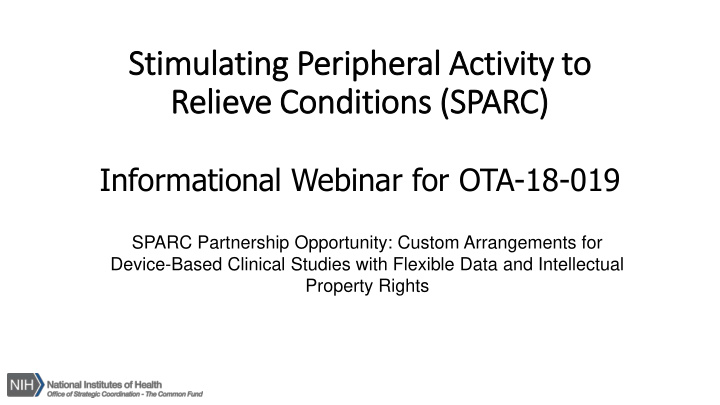



Stimulating Peripheral Activity to Relieve Conditions (SPARC) Informational Webinar for OTA-18-019 SPARC Partnership Opportunity: Custom Arrangements for Device-Based Clinical Studies with Flexible Data and Intellectual Property Rights
SPARC - Stimulating Peripheral Activity to Relieve Conditions NIH Common Fund Program Challenge: Neuromodulation of organ function holds promise in treating many diseases. However, the mechanisms of action for neuromodulation therapies remain poorly understood. Results among patients are highly variable. Sham effects are large. Mission: Catalyze rational target development for peripheral neuromodulation indications by building anatomical and functional maps of the autonomic nervous system in relation to major organs .
SPARC High-Level Plan MAPS Maps 1.0 Maps 2.0 TOOLS New tools (exploratory) New tools (specific, need-driven) Seek program renewal if successful TRANSLATION Build public-private partnerships Leverage public-private partnerships for human functional mapping DATA “Next - gen” data sharing 2019 2020 2021 2015 2016 2017 2018
Objectives of f Part rtnership Announcement OTA-18 18-019 Create partnerships around device-based clinical studies to catalyze collection of human research data in support of the SPARC mission ➢ Beyond those addressing clinical health-endpoints ➢ Neuromodulatory interventions targeting the peripheral nervous system or the spinal cord ➢ Enhance anatomical and functional understanding of ➢ New, planned or ongoing clinical studies the neural control of end-organs ➢ May utilize invasive or non-invasive techniques to ➢ May involve acute or short-term procedures measure neural activity or biomarkers of organ function Example device study: Neuromodulation for bladder control ▪ Primary health outcome: Incontinence episodes and urinary frequency -> Insufficient data ▪ Additional data: Quantitative urodynamic measures (e.g. bladder pressure)
Non-responsive activities • Direct brain stimulation • Neuromodulation of sensory organs of the head or voluntary muscles • Non-clinical testing • Pivotal device trials • Proposals focusing exclusively on therapeutic feasibility
Objectives of f Part rtnership Announcement OTA-18 18-019 Create partnerships around device-based clinical studies to catalyze collection of human research data in support of the SPARC mission ▪ Negotiations to establish partnerships may result in Other Transactions (OT2) awards (Not grants, contracts or cooperative agreements) ▪ Awards will have Terms & Conditions that are customized on a case-by-case basis (e.g. data sharing requirements) ▪ OT mechanism provides flexibility to design unique collaborations with private sector entities ▪ OT awards involve active NIH program management See SPARC Other Transactions Award Policy Guide: https://commonfund.nih.gov/sparc/othertransactions
Tim imeline and Submission Process Proposal due date Earliest award start date Oct 15, 2018 (11:59 pm EST) Feb 4, 2019 Jul Aug Sep Oct Nov Dec Jan Feb Review and negotiations Mandatory Letter of Intent Sep 7, 2018 (11:59 pm EST) Proposal Submission: 2 steps 1. Email attachment (PDF format) to SPARC_TPNI@mail.nih.gov by an authorized representative ( no late applications accepted ) 2. In addition, submit online via NIH eRA ASSIST system (instructions provided inside announcement). No penalties for late submission due technical difficulties.
Application Content Cover Page Study plan • Describe study objectives and rationale • Task plan should include milestones with quantitative metrics (example table provided) Human Subjects Research Plan • Refer to guidance document - Human Subjects and Clinical Research Information Capabilities • Roles of key personnel and their institutions in accomplishing study objectives Budget • Overall expected costs and justification per year for personnel, equipment, travel, subawards (refer to budget table template) Data Deliverable • Plan for release of data to SPARC Data and Resource Center • Must align with SPARC Material Sharing Policy Additional Information • Letters of support (Institutional, recruitment sites, industry collaborators)
Obje jective Review Not traditional peer review • Participation of NIH Program staff along with external experts • Written summary of review instead of summary statements Criteria • Scientific Merit • Personnel and Environment • Clinical Study Practices • Institutional Capabilities
Public-Private Partnership Resources Industry partners: Several device companies have agreed to consider collaborations and to make their technology available to SPARC-supported investigators ➢ See SPARC program website for list of companies and points of contact Template agreement documents to facilitate collaborations: Confidential Disclosure Agreement (CDA) • Enables transfer of technical details necessary to inform application. Collaborative Research Agreement (CRA) • Rules and responsibilities governing data and intellectual property.
Regulatory ry and IR IRB Approvals • Studies may span IRB-approved non-significant risk studies or significant risk studies requiring an Investigation Device Exemption from the FDA • Approvals (IDE and/or IRB) to initiate study must be secured within the first six months • If necessary, a pre-submission meeting with FDA will need to be held within the first 3 months • Awards will be restricted until all regulatory approval are obtained
FAQs • Do we need to collaborate with an existing SPARC awardee? • Do we have to choose an industry partner from the existing SPARC list? • What is an appropriate budget? • Number of patients or human subjects? • Does the study need to involve a market-approved device? • Does the research data have to be relevant for specific organs? • Is new patient recruitment required? • Does it have to be an Early Feasibility Study?
Recommend
More recommend